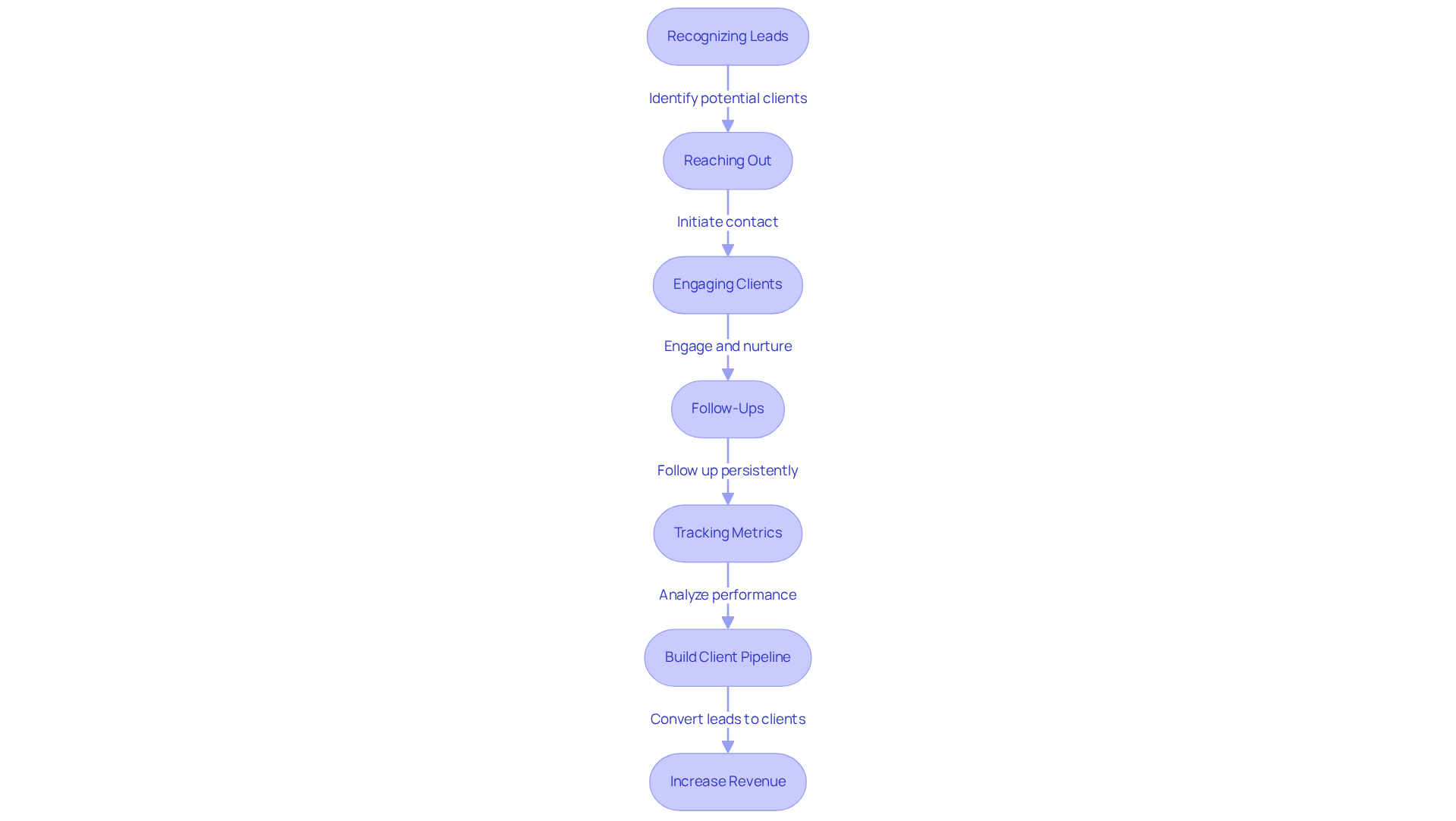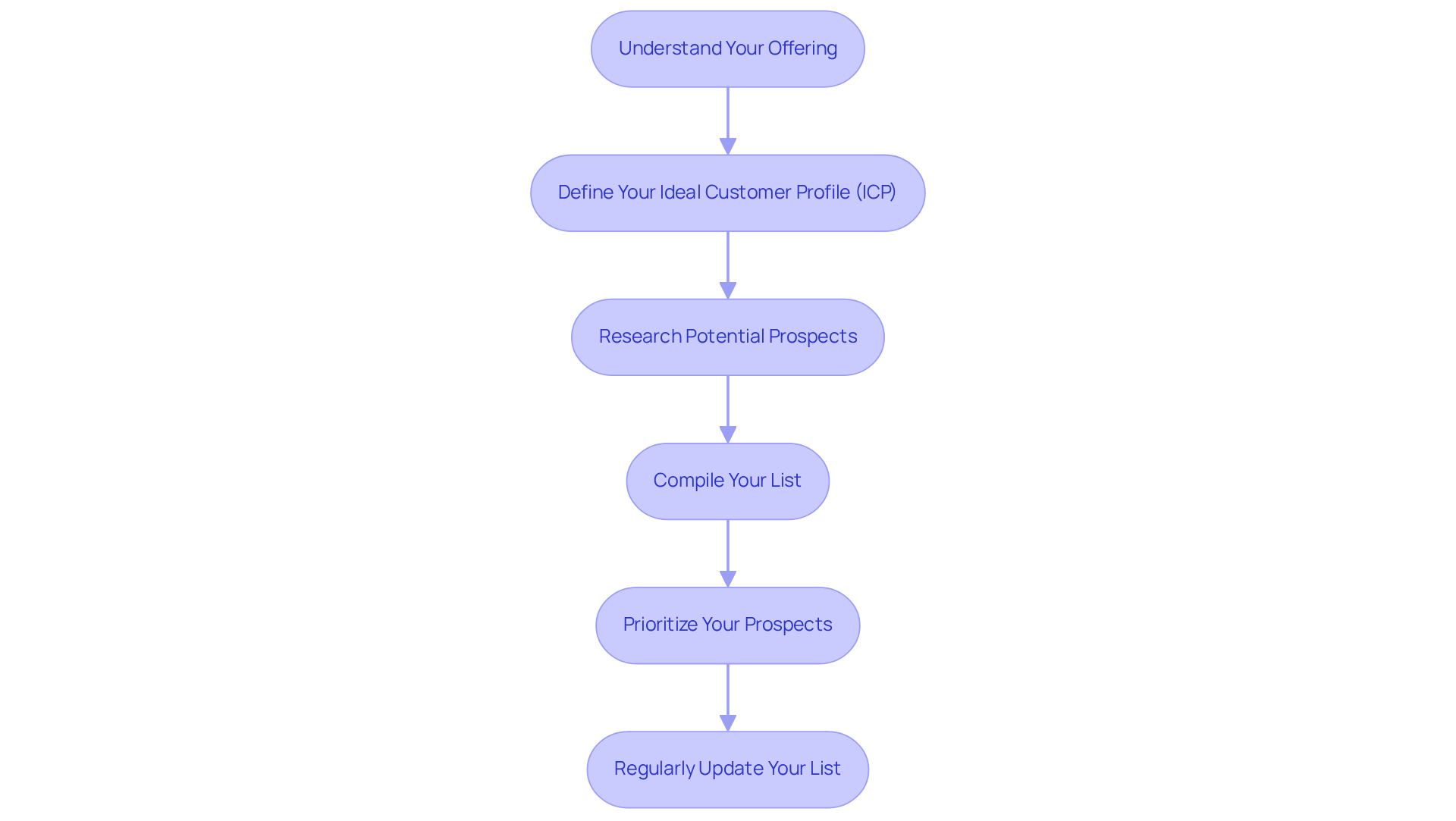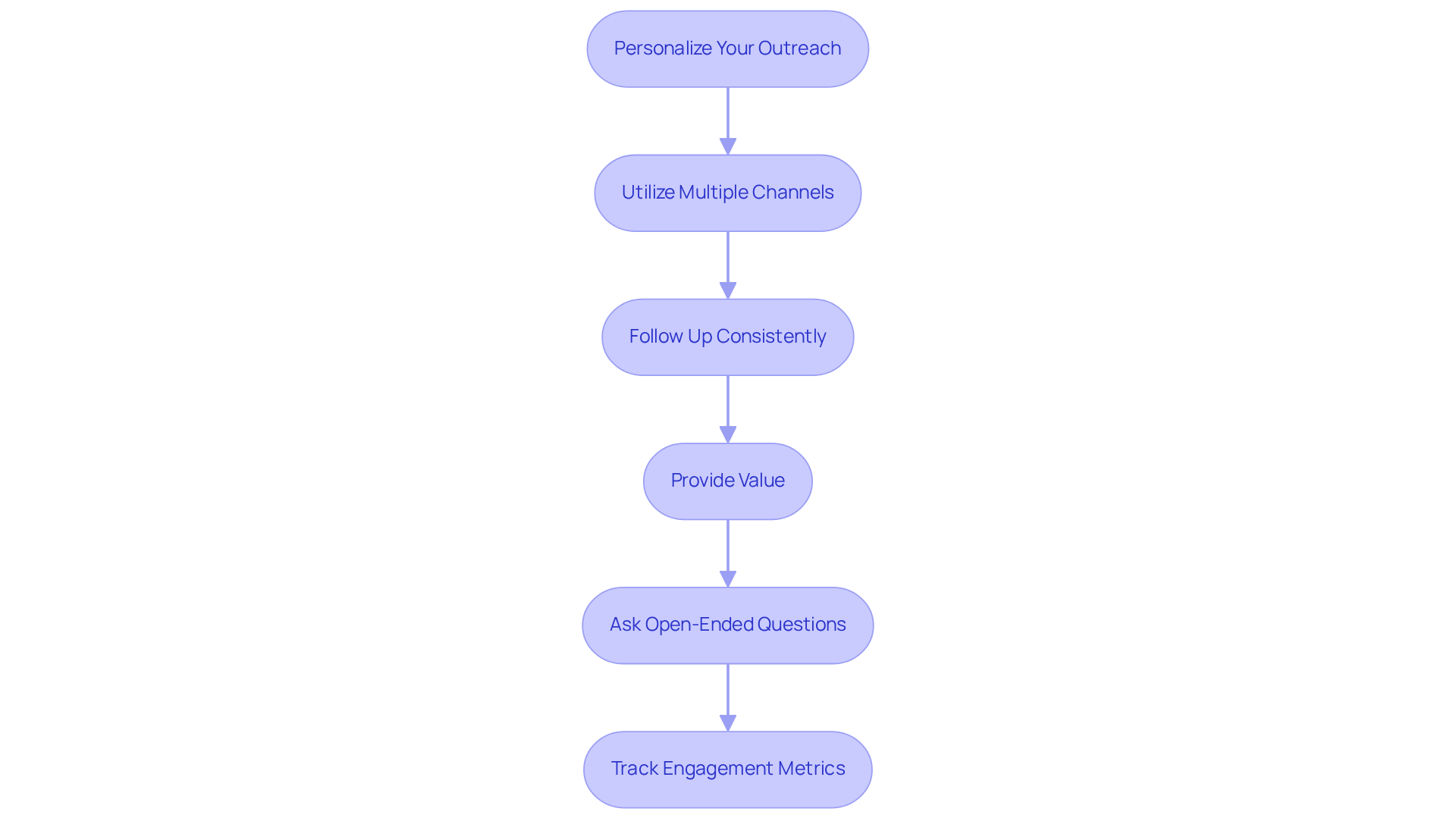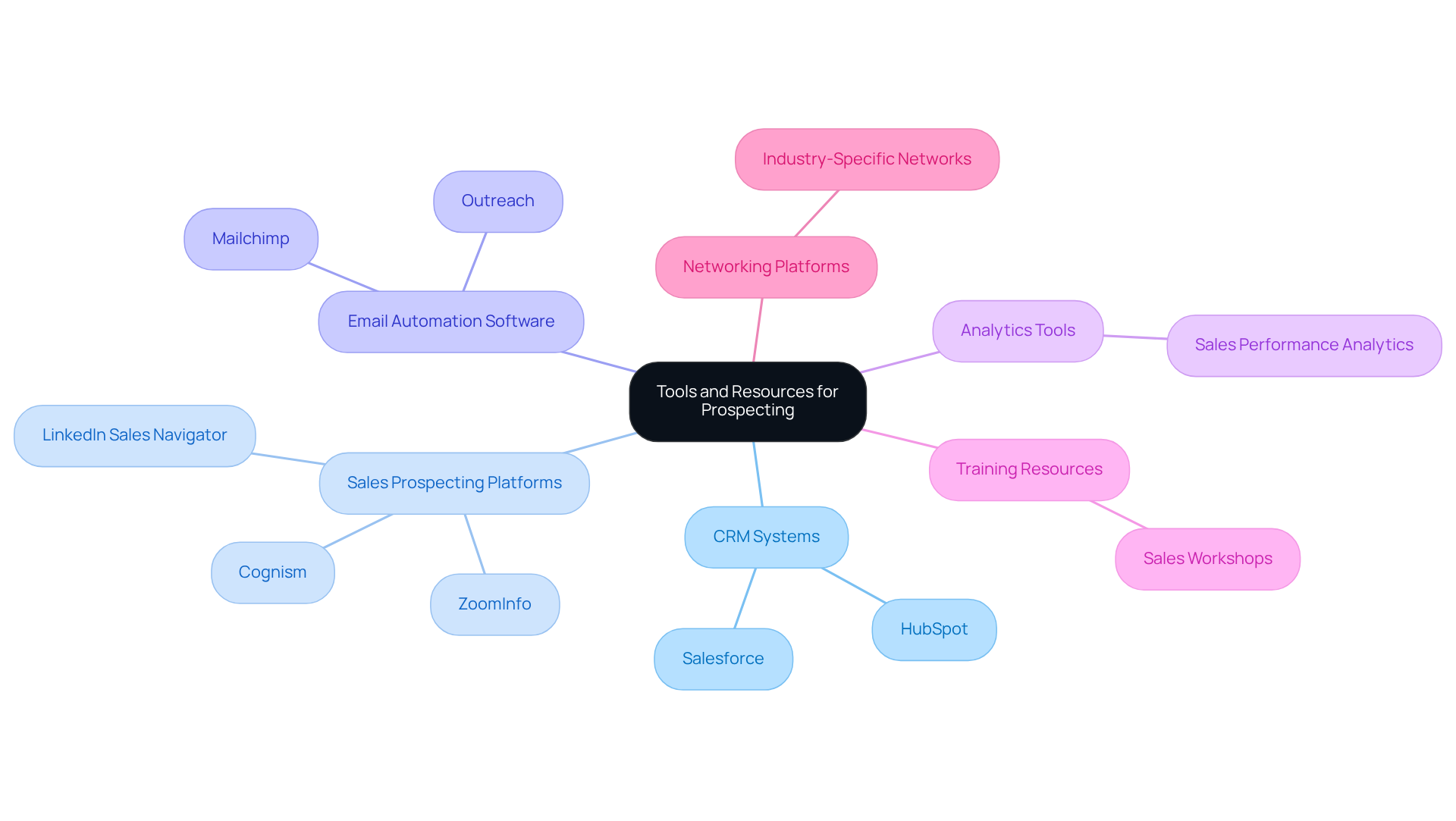Overview
This article offers a compassionate guide for small businesses aiming to master sales prospecting. We understand that building a strong client pipeline is crucial for increasing revenue, and this process can feel overwhelming. By breaking it down into step-by-step strategies, we aim to empower you with practical tools to succeed.
First, it’s essential to understand your offerings. What unique value do you bring to your customers? Next, defining your ideal customer profile will help you focus your efforts effectively. Who are the individuals that would benefit most from your services? By answering these questions, you lay the groundwork for successful outreach.
Utilizing various outreach methods is another key step. Whether it’s social media, email campaigns, or networking events, each method has its strengths. Statistics show that these strategies significantly enhance client engagement and conversion rates. Together, we can explore these avenues to find what resonates best with your audience.
In conclusion, mastering sales prospecting is not just about techniques; it’s about building relationships. We encourage you to take these insights and implement them in your business. Remember, you are not alone in this journey. Together, we can achieve success and create meaningful connections with your clients.
Introduction
In a landscape where small businesses face relentless competition, we understand that mastering the art of sales prospecting is crucial for your success. Effective prospecting not only opens the door to new clients but also establishes your company as a trusted advisor, paving the way for sustainable growth. Yet, with so many strategies and tools available, how can you navigate the complexities of building a robust prospecting list and engaging potential clients effectively?
This guide offers a step-by-step approach to streamline your prospecting process, ensuring that you can maximize your outreach and boost your revenue potential. Together, we can achieve success in this challenging environment.
Define Sales Prospecting and Its Importance
Prospecting in sales involves recognizing and reaching out to potential clients, referred to as leads, to generate new income. This process is essential in the business cycle, aiding organizations in prospecting to build a solid pipeline of prospective clients. When done effectively, prospecting enhances the chances of closing deals and also positions your company as a trusted advisor in the eyes of potential clients.
As small business owners, understanding the importance of prospecting enables you to focus your efforts on high-quality leads, resulting in increased revenue and sustainable growth. For example, businesses that actively engage in prospecting can expect to create over 60 target client connections each month. This can significantly enhance their revenue pipeline and ensure a steady stream of new clients, which is crucial for long-term success.
In today’s competitive market, where 80% of transactions require five or more follow-ups, a thoughtful approach to prospecting is essential for maximizing your revenue potential. With Wayy.ai, you can simplify your client acquisition process through features like a one-click sales guide and targeted engagement.
Additionally, daily email insights provide you with key metrics on leads reached, interest shown, and conversion rates. This empowers you to track your performance and make informed decisions to improve your sales strategies. Remember, together we can achieve success in navigating the challenges of client acquisition.

Build Your Sales Prospecting List: A Step-by-Step Process
- Understand Your Offering: To truly connect with your audience, start by gaining a deep understanding of your products or services. Embrace the features, benefits, and unique selling propositions that set you apart from competitors. This knowledge will empower you to communicate with confidence and authenticity.
- Define Your Ideal Customer Profile (ICP): Who are your ideal customers? Identifying their characteristics—such as demographics, industry, company size, and pain points—can profoundly impact your marketing efforts. A well-defined ICP allows you to focus on the most promising segments, significantly increasing your conversion rates. In fact, companies that apply an ICP have reported revenue growth of up to 25%. Imagine the possibilities this could unlock for your business.
- Research Potential Prospects: Take advantage of online resources, social media, and industry databases for prospecting to discover potential leads that align with your ICP. Tools like LinkedIn Sales Navigator and Wiza can open doors to extensive databases of B2B contacts, making your outreach efforts more efficient and effective.
- Compile Your List: Consider creating a spreadsheet or utilizing a CRM tool to organize your potential clients. Include essential information such as names, contact details, and notes on their needs or interests. This structured approach enhances your ability to tailor communications effectively, ensuring that your outreach resonates with each individual.
- Prioritize Your Prospects: As you compile your list, take a moment to rank your prospects based on their likelihood to convert. Focus on those who show the most promise, such as individuals who have engaged with your content or expressed interest in your offerings. Remember, companies that respond to leads within an hour are seven times more likely to qualify them than those that delay. This urgency can make a significant difference in your success.
- Regularly updating your prospecting list is essential to keep it current. Regularly review and update it based on new information or changes in your business strategy. This practice ensures that your outreach remains relevant and effective. After all, 63% of respondents express frustration with brands that rely on outdated, generic messaging. Together, we can ensure your communications are always fresh and engaging.

Engage Prospects Effectively: Outreach Strategies That Work
- Personalize Your Outreach: It's essential to tailor your messages to each potential client, considering their unique needs and interests. By incorporating their name and referencing any previous interactions, you can foster a genuine connection. Remember, personalization matters; 76% of consumers express frustration when they don’t receive tailored communications. This highlights the importance of meeting these expectations.
- Utilize Multiple Channels: Engaging potential clients through various channels—such as email, social media, and phone calls—can make a significant difference. This multi-channel approach not only increases your chances of reaching them effectively but also resonates with the 69% of consumers who expect consistent personalized experiences across different platforms.
- Follow Up Consistently: Don’t hesitate to check in with potential clients who haven’t responded. A gentle reminder can often prompt a response. By employing a mix of prospecting methods, such as emails and calls, you can maintain engagement. Consistent prospecting can significantly enhance your conversion rates, demonstrating to clients that you care.
- Provide Value: Sharing valuable content, like industry insights or helpful resources, positions you as a knowledgeable partner. This not only fosters trust but also motivates potential customers to engage further. Consumers are more likely to connect with brands that provide meaningful information, so be that source of value.
- Ask Open-Ended Questions: During your conversations, try posing questions that encourage potential clients to share their challenges and needs. This information is invaluable for customizing your solutions, ultimately improving the relevance of your engagement. It shows that you genuinely care about their concerns.
- Track Engagement Metrics: Utilize Wayy.ai's daily email insights to observe how prospects engage with your efforts. With updates on key metrics—such as how many leads were reached, who showed interest, and the conversion rate—you can gain valuable insights into effective strategies. Additionally, Wayy.ai's one-click sales playbook and focused engagement features can streamline your client acquisition process, empowering you to achieve success together.

Leverage Tools and Resources for Enhanced Prospecting
-
Customer Relationship Management (CRM) Systems: Have you considered implementing a CRM like HubSpot or Salesforce? These tools can truly help you manage your potential clients and track interactions effectively for prospecting. By organizing your engagement efforts, you can sustain meaningful relationships that matter.
-
Sales prospecting involves utilizing tools such as LinkedIn Sales Navigator, ZoomInfo, or Cognism. These platforms are designed to help you identify and gather valuable information on potential leads, providing insights into their behaviors and interests that can guide your approach.
-
Email Automation Software: Streamlining your outreach process can be a game-changer. Email automation tools like Mailchimp or Outreach allow you to schedule emails, track opens, and manage follow-ups efficiently, ensuring that your communication remains consistent and effective.
-
Analytics tools: Have you ever wondered how effective your prospecting efforts really are? Leveraging analytics tools can help you measure the success of your strategies. By understanding which approaches yield the best results, you can refine your methods and achieve greater success.
-
Investing in training resources or workshops focused on sales prospecting can significantly enhance your skills. Continuous learning empowers you to engage prospects more effectively, building confidence in your abilities.
-
Networking Platforms: Engaging with industry-specific networking platforms can open doors to connect with potential clients and partners. Building relationships within these communities not only fosters connections but can also lead to valuable referrals and opportunities that support your growth.

Conclusion
Mastering the art of sales prospecting is essential for small businesses striving to succeed in a competitive environment. By thoughtfully identifying and reaching out to potential clients, you can build a strong pipeline that not only boosts revenue but also positions your business as a trusted advisor in your industry. The insights shared in this guide highlight how a well-structured prospecting strategy can transform your long-term success.
Key strategies such as:
- Defining your ideal customer profile
- Personalizing your outreach
- Utilizing various tools and resources
have been thoroughly explored. Understanding your offerings, conducting diligent research, and employing CRM systems can greatly enhance the effectiveness of your prospecting efforts. Moreover, consistent follow-ups and delivering value through relevant content can nurture genuine connections with potential clients, ultimately leading to conversions.
In conclusion, the importance of effective sales prospecting cannot be overstated. As a small business owner, you are encouraged to embrace these strategies and tools, tailoring them to your unique needs. By prioritizing prospecting, you can not only secure a steady influx of new clients but also foster lasting relationships that are crucial for sustainable growth. Take that first step today towards refining your prospecting approach, and witness your business flourish.
Frequently Asked Questions
What is sales prospecting?
Sales prospecting involves recognizing and reaching out to potential clients, known as leads, to generate new income.
Why is prospecting important for businesses?
Prospecting is essential in the business cycle as it helps organizations build a solid pipeline of prospective clients, enhances the chances of closing deals, and positions the company as a trusted advisor.
How does effective prospecting impact revenue?
When done effectively, prospecting allows businesses to focus on high-quality leads, resulting in increased revenue and sustainable growth. For instance, businesses that actively engage in prospecting can create over 60 target client connections each month, significantly enhancing their revenue pipeline.
What is the significance of follow-ups in sales prospecting?
In today’s competitive market, 80% of transactions require five or more follow-ups, making a thoughtful approach to prospecting essential for maximizing revenue potential.
How can Wayy.ai assist in the prospecting process?
Wayy.ai simplifies the client acquisition process through features like a one-click sales guide and targeted engagement, along with daily email insights that provide key metrics on leads reached, interest shown, and conversion rates.
What benefits do daily email insights provide in sales prospecting?
Daily email insights empower businesses to track their performance and make informed decisions to improve their sales strategies by providing key metrics on leads and conversion rates.




